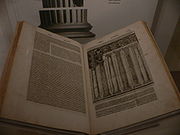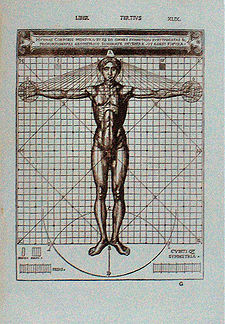
Cesare Cesariano
Encyclopedia

Architect
An architect is a person trained in the planning, design and oversight of the construction of buildings. To practice architecture means to offer or render services in connection with the design and construction of a building, or group of buildings and the space within the site surrounding the...
and architectural theorist in Milan
Milan
Milan is the second-largest city in Italy and the capital city of the region of Lombardy and of the province of Milan. The city proper has a population of about 1.3 million, while its urban area, roughly coinciding with its administrative province and the bordering Province of Monza and Brianza ,...
, known to Donato Bramante
Donato Bramante
Donato Bramante was an Italian architect, who introduced the Early Renaissance style to Milan and the High Renaissance style to Rome, where his most famous design was St...
ca. 1474, according to Bramante's vita by Giorgio Vasari
Giorgio Vasari
Giorgio Vasari was an Italian painter, writer, historian, and architect, who is famous today for his biographies of Italian artists, considered the ideological foundation of art-historical writing.-Biography:...
, who says of the young, as yet untried Bramante:
- "Determined to see at least one notable thing, he preceded to Milan to visit the Duomo, where there happened to be one Cesare Cesariano, reputed a good geometer and architect, who had written a commentary on Vitruvius. Enraged at not having received the reward which he had expected, Cesare refused to work any more, and, becoming eccentric, he died more like a beast than a man."

Vitruvius
Marcus Vitruvius Pollio was a Roman writer, architect and engineer, active in the 1st century BC. He is best known as the author of the multi-volume work De Architectura ....
' treatise De Architectura
De architectura
' is a treatise on architecture written by the Roman architect Vitruvius and dedicated to his patron, the emperor Caesar Augustus, as a guide for building projects...
into a modern language (Italian), with his added commentary. It was published, with copious woodcut illustrations, at Como
Como
Como is a city and comune in Lombardy, Italy.It is the administrative capital of the Province of Como....
, 1521. It contained 360 pages and was printed in 1300 copies. It was soon plagiarized in editions published at Venice, but all were superseded by Daniele Barbaro
Daniele Barbaro
Daniele Matteo Alvise Barbaro was an Italian translator of, and commentator on, Vitruvius. He also had a significant ecclesiastical career, reaching the rank of Cardinal....
's edition, with illustrations by Andrea Palladio
Andrea Palladio
Andrea Palladio was an architect active in the Republic of Venice. Palladio, influenced by Roman and Greek architecture, primarily by Vitruvius, is widely considered the most influential individual in the history of Western architecture...
, 1556.
Vitruvius' technical language is fraught with difficulties. Leone Battista Alberti
Leone Battista Alberti
Leon Battista Alberti was an Italian author, artist, architect, poet, priest, linguist, philosopher, cryptographer and general Renaissance humanist polymath...
was of the mind that the Latins thought Vitruvius was writing Greek and the Greeks, Latin. The impenetrable Latin and the lack of illustrations gave freedom to the Renaissance designers, who were able to interpret antique architecture in their own image, all' antica. Cesariano's Vitruvius gives us a clear picture of the Renaissance perception of the architecture of Classical Antiquity
Classical antiquity
Classical antiquity is a broad term for a long period of cultural history centered on the Mediterranean Sea, comprising the interlocking civilizations of ancient Greece and ancient Rome, collectively known as the Greco-Roman world...
. Indeed the spirit of Milan's Late Gothic Duomo
Duomo
Duomo is a term for a cathedral church. The formal word for a church that is presently a cathedral is cattedrale; a Duomo may be either a present or a former cathedral . Some, like the Duomo of Monza, have never been cathedrals, although old and important...
can be recognized in some of Cesariano's woodcuts http://rubens.anu.edu.au/htdocs/bytype/arch.sources/vitruvius/. Among his illustrations is an attempt at rendering Vitruvius' precepts on the ideally proportioned man, successfully rendered by Leonardo
Leonardo da Vinci
Leonardo di ser Piero da Vinci was an Italian Renaissance polymath: painter, sculptor, architect, musician, scientist, mathematician, engineer, inventor, anatomist, geologist, cartographer, botanist and writer whose genius, perhaps more than that of any other figure, epitomized the Renaissance...
, but attempted by many 15th century theorists http://leonardodavinci.stanford.edu/submissions/clabaugh/history/othermen.html
Cesariano's illustrations, though not as influential as Sebastiano Serlio
Sebastiano Serlio
Sebastiano Serlio was an Italian Mannerist architect, who was part of the Italian team building the Palace of Fontainebleau...
's, had some influence in the picturesque and classicizing vocabulary of the Northern Antwerp Mannerism
Antwerp Mannerism
Antwerp Mannerism is the name given to the style of a largely anonymous group of painters from Antwerp in the beginning of the 16th century. The style bore no direct relation to Renaissance or Italian Mannerism, but the name suggests a peculiarity that was a reaction to the "classic" style of the...

